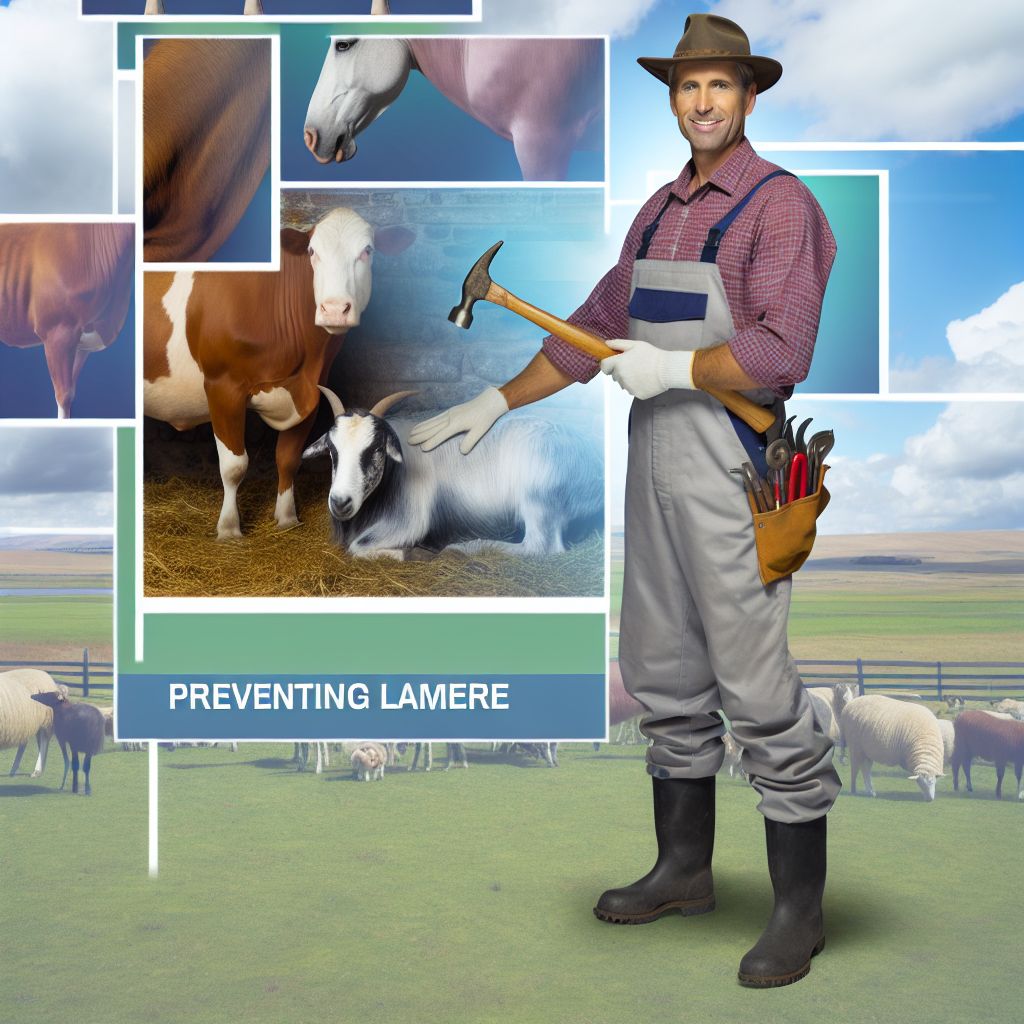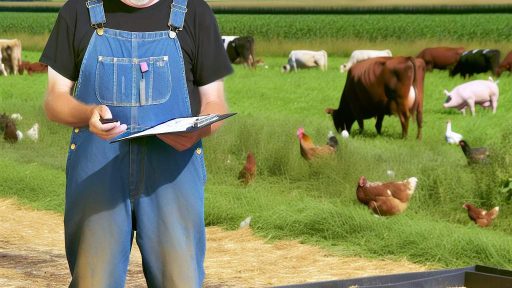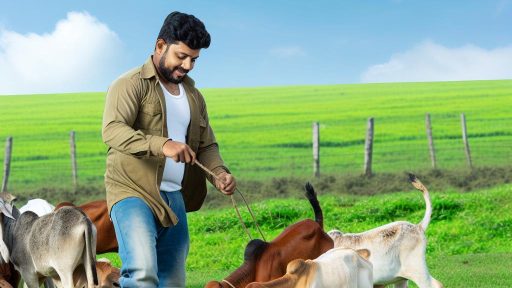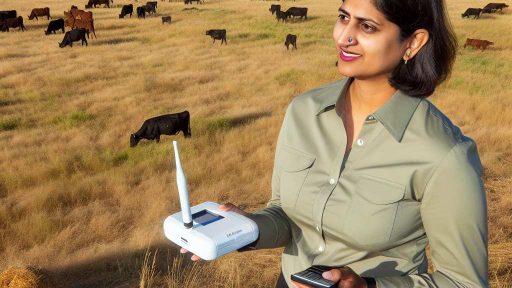Introduction to Lameness in Farm Animals
Lameness remains a significant issue among farm animals worldwide.
Statistical reports indicate that it affects 20-30% of livestock annually.
This condition can lead to decreased productivity and performance.
Moreover, lameness increases veterinary costs and management challenges.
Farmers often face severe economic losses due to lameness.
Understanding its causes is crucial for effective prevention.
Genetic, nutritional, and environmental factors play essential roles.
Regular monitoring of animal health can help identify problems early.
Timely intervention can significantly reduce the impact of lameness.
Overall, proper foot care emerges as a vital component of prevention.
By prioritizing foot health, farmers can enhance animal welfare.
This, in turn, can improve production efficiency and profitability.
Thus, addressing lameness is a shared responsibility within the farming community.
Understanding the Anatomy of Animal Hooves and Feet
Basic Structure of Hooves
Animal hooves consist of several key components.
The outer layer is known as the hoof wall.
Transform Your Agribusiness
Unlock your farm's potential with expert advice tailored to your needs. Get actionable steps that drive real results.
Get StartedThis wall protects the inner structures effectively.
Below the hoof wall lies the sensitive laminae.
These laminae attach the hoof to the underlying bone.
Furthermore, the sole provides a protective barrier as well.
Importance of Digital Cushion
The digital cushion plays a crucial role in shock absorption.
This structure helps to protect the bones and joints during movement.
Additionally, it aids in blood circulation within the hoof.
Common Hoof Types in Farm Animals
Diverse farm animals have unique hoof structures.
Equines, such as horses, possess solid hooves.
Conversely, ruminants like cows have cloven hooves.
These differences affect their mobility and care requirements.
Foot and Hoof Health Factors
Several factors influence hoof health in farm animals.
Nutrition significantly impacts hoof quality and growth.
Maintaining proper hygiene prevents infections and diseases.
Regular hoof trimming is essential for optimal foot health.
Moreover, environmental conditions can exacerbate hoof issues.
Common Foot-Related Issues That Lead to Lameness
Understanding Lameness in Farm Animals
Lameness in farm animals is often a significant concern for farmers.
It affects the health and productivity of livestock.
Addressing foot-related problems is crucial for prevention.
Common Foot-Related Issues
Various conditions can lead to lameness in farm animals.
Understanding these conditions is essential for effective management.
Foot Rot
Foot rot is a bacterial infection affecting the hooves.
This condition primarily occurs in cattle and sheep.
Wet and muddy environments increase the risk of infection.
Showcase Your Farming Business
Publish your professional farming services profile on our blog for a one-time fee of $200 and reach a dedicated audience of farmers and agribusiness owners.
Publish Your ProfileDigital Dermatitis
Digital dermatitis is a painful skin infection on the heel of the foot.
This issue is common in dairy cattle.
It can lead to chronic lameness if left untreated.
Hoof Overgrowth
Hoof overgrowth occurs when hooves are not properly trimmed.
This condition can cause discomfort and affect mobility.
Regular hoof maintenance is essential to prevent overgrowth.
Interdigital Cysts
Interdigital cysts develop between the toes due to irritation.
These cysts can become infected and lead to lameness.
Proper foot hygiene can help to prevent this issue.
Signs of Foot-Related Problems
Farmers should be vigilant for signs of lameness.
Notable symptoms include limping and reluctance to move.
Additionally, animals may display swelling in the hoof area.
Preventive Measures
Implementing proper foot care practices is crucial.
Regular hoof trimming ensures healthy foot structure.
Maintaining dry living conditions can prevent infections.
Regular foot inspections can help identify issues early.
Importance of Early Detection
Identifying foot problems early leads to better outcomes.
Timely treatment reduces the risk of chronic lameness.
Furthermore, early intervention can prevent economic losses.
Delve into the Subject: Choosing Heritage Chicken Breeds For More Robust Poultry Farm Operations
The Role of Nutrition in Maintaining Proper Foot Health
Essential Nutrients for Foot Health
Proper nutrition supports the overall health of farm animals.
Minerals like zinc and copper play a critical role in hoof integrity.
Calcium is vital for strong bones and can affect foot structure.
Protein is necessary for hoof growth and repair.
Vitamins such as A, D, and E enhance skin and hoof health.
The Impact of Diet on Hoof Quality
A well-balanced diet leads to robust hoof structure.
Deficiencies in essential nutrients can weaken hooves.
Healthy hooves reduce the risk of lameness in farm animals.
Regular dietary evaluation helps maintain optimal foot health.
Water Intake and Hydration
Hydration is crucial for overall health in farm animals.
It directly influences hoof condition and flexibility.
Dehydration can lead to dry, brittle hooves.
Ensure animals have access to clean and fresh water at all times.
Feed Quality and Foot Health
The quality of feed affects animal health and hoof integrity.
Contaminated or low-quality feed can lead to nutritional deficiencies.
Regularly inspect feed sources for contaminants and ensure freshness.
Consult a nutritionist for formulating a balanced diet specific to species.
Supplementation for Optimal Health
Adding supplements can improve hoof quality when needed.
Consider biotin and other hoof-specific supplements for enhancement.
Always consult with a veterinarian before starting supplementation.
Showcase Your Farming Business
Publish your professional farming services profile on our blog for a one-time fee of $200 and reach a dedicated audience of farmers and agribusiness owners.
Publish Your ProfileMonitor improvements in hoof health after supplement introduction.
Delve into the Subject: Poultry Management for Controlling Parasites
Routine Foot Care Practices
Trimming
Regular trimming keeps hooves at a healthy length.
This practice helps prevent abnormal hoof shapes.
Utilize sharp and clean tools for effective trimming.
Trimming should be done every few weeks for best results.
Monitor the hoof condition to catch any issues early.
Cleaning
Clean hooves reduce the risk of infections.
Wash hooves with clean water to remove dirt and debris.
Pay attention to crevices where dirt can accumulate.
Use a hoof pick to clear out stubborn material.
Regular cleaning promotes overall foot health in animals.
Inspection
Frequent hoof inspections can identify problems early.
Look for signs of lameness or unusual wear.
Check for cracks, abscesses, or foreign objects.
Document any findings to track changes over time.
Engage a veterinarian for persistent issues or concerns.
Delve into the Subject: Innovative Queen Bee Breeding Methods For Robust Colonies In U.S. Agriculture
Importance of Proper Housing and Environment for Foot Care
Creating a Comfortable Living Space
Adequate space allows animals to move freely.
It reduces stress and promotes better foot health.
Comfortable housing minimizes the risk of injuries.
Proper bedding provides cushioning for their feet.
Maintaining Cleanliness
Regular cleaning prevents the buildup of waste.
Excess waste results in poor foot hygiene.
Introduce effective drainage systems for moisture control.
Dry environments help keep hooves healthy.
Temperature Control
Temperature extremes can cause foot problems.
Proper ventilation helps regulate barn temperatures.
Adequate warmth in winter is crucial for foot care.
Cool, shaded areas in summer prevent overheating.
Safe Flooring Materials
The choice of flooring impacts foot health significantly.
Non-slip surfaces prevent slips and falls.
Soft materials reduce pressure on their hooves.
Regular inspection ensures flooring remains safe and secure.
Access to Outdoor Spaces
Outdoor access promotes natural behaviors in animals.
Exposure to varied terrain strengthens hooves.
Grass and dirt surfaces provide natural wear.
Balanced access to shelter and outdoors enhances well-being.
Uncover the Details: Understanding the Role of Sensors in Precision Livestock Farming

Signs to Look for in Early Detection of Foot Problems
Behavioral Changes
Observe animals for changes in their movement patterns.
Showcase Your Farming Business
Publish your professional farming services profile on our blog for a one-time fee of $200 and reach a dedicated audience of farmers and agribusiness owners.
Publish Your ProfileUnusual limping may indicate potential foot issues.
Additionally, reluctance to move can be a key sign.
Watch for decreased grazing or feeding behavior.
Visual Indicators
Inspect each animal’s feet regularly for abnormalities.
Swelling around the hooves can suggest infections.
Look for cracks or lesions on the hooves as warning signs.
Notice any discoloration, which may indicate underlying problems.
Behavioral Responses
Pay attention to how animals react when examined.
Signs of pain, such as flinching, may be present.
Listen for vocalizations, as they can indicate discomfort.
Animals standing with an unusual posture can signal pain.
Environmental Factors
Evaluate the living conditions of your livestock regularly.
Poor hygiene in bedding can cause foot problems over time.
Wet or muddy conditions can lead to hoof diseases.
Ensure proper drainage to maintain a healthy environment.
Regular Monitoring
Implement a routine foot care program for all animals.
Frequent hoof trimming can prevent many foot issues.
Incorporate regular foot inspections into your daily tasks.
Document any foot problems to track patterns over time.
Best Practices for Managing Foot Health Across Different Livestock Species
Cattle Care
Regular hoof trimming is essential for cattle health.
This practice prevents overgrowth and associated lameness.
Furthermore, maintaining dry and clean living conditions minimizes foot rot risks.
Routine foot inspections help identify problems early.
Additionally, providing proper nutrition supports strong hoof development.
Sheep Management
Sheep require regular foot checks to maintain health.
Trimming their hooves prevents overgrowth and infections.
Offering a clean, dry environment reduces the risk of foot issues.
It is also important to monitor pasture conditions to prevent foot rot.
Moreover, vaccination against diseases can play a crucial role.
Swine Feet Health
Pigs need regular hoof trimming to prevent lameness.
Monitoring their environment for wet conditions is vital.
Providing proper bedding can help keep their feet dry.
Feeding a balanced diet supports overall hoof condition.
Additionally, ensure that their living space is clean to avoid infections.
Poultry Foot Care
Poultry also require foot care, though it differs from larger livestock.
Regular inspections for bumblefoot in chickens are necessary.
Providing proper perches mitigates foot injuries.
Keep surfaces clean to prevent foot problems.
Ensuring a balanced diet contributes to healthy feet and overall well-being.
General Recommendations
Maintaining a clean environment is crucial for all livestock species.
Showcase Your Farming Business
Publish your professional farming services profile on our blog for a one-time fee of $200 and reach a dedicated audience of farmers and agribusiness owners.
Publish Your ProfileRegular veterinary check-ups can help prevent and treat foot ailments.
Implement a systematic routine for foot health management.
Education about common foot health issues is vital for livestock owners.
Ultimately, proactive foot care leads to healthier, more productive animals.
Economic Benefits of Investing in Proper Foot Care
Improved Animal Health
Proper foot care significantly enhances the overall health of farm animals.
Healthy animals exhibit better growth rates and productivity.
When animals are less prone to lameness, they can feed more efficiently.
This leads to improved weight gain and milk production.
Reduction in Veterinary Costs
Investing in foot care lowers veterinary expenses in the long run.
Preventing lameness reduces the need for medical interventions.
Additionally, routine foot maintenance helps avoid serious injuries.
This keeps treatment costs down, benefiting the overall budget.
Enhanced Livestock Performance
Animals with proper foot care perform better in various metrics.
They show increased endurance during work or competition.
This enhances the profitability of livestock in farming operations.
Farmers can maximize their returns on investment as a result.
Improved Reproductive Efficiency
Healthy feet contribute to better reproductive outcomes in livestock.
Animals that are not lame can breed more effectively.
This leads to higher pregnancy rates and healthier offspring.
Ultimately, better reproduction translates into increased livestock numbers.
Boosted Profitability
Investing in foot care directly boosts the profits of a farm.
Less money spent on vet bills means more to reinvest in the farm.
Healthy, productive animals generate more income through sales.
Effective foot care is thus an essential element of farm financial planning.
Additional Resources
Guide for the Care and Use of Agricultural Animals in Research and …




